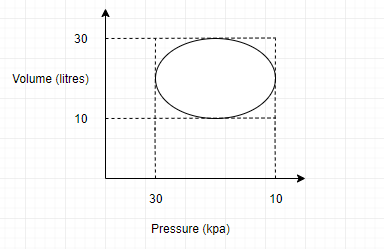
The heat energy absorbed by a system in going through a cyclic process shown in figure is:

A.
B.
C.
D.

Answer
497.4k+ views
Hint: The graph of a cyclic process is given in the question. Here, the system starts the process and further returns to the same thermodynamic state. To find out the heat energy that is absorbed, we have to find out the work done in the entire process from the given P-V graph.
Formulas used:
Complete step by step answer:
Since the process is cyclic and it returns to the initial state, the change in internal energy doesn’t take place, i.e.
On applying the first law of thermodynamics, i.e.
We get the value of
Work done by the thermodynamic system is the enclosed area of the graph.
Hence,
Here, a is the semi major axis and b is the semi minor axis of the ellipse.
Therefore
Hence, option C is the right answer among the given options.
Note:Cyclic process is the underlying principle of the functioning of engines. When the graph goes clockwise, we can say that the value of W is positive and this represents a heat engine and if it goes counter clockwise, the value of W is negative and it will act as a heat pump.
Formulas used:
Complete step by step answer:
Since the process is cyclic and it returns to the initial state, the change in internal energy doesn’t take place, i.e.
On applying the first law of thermodynamics, i.e.
We get the value of
Work done by the thermodynamic system is the enclosed area of the graph.
Hence,
Here, a is the semi major axis and b is the semi minor axis of the ellipse.
Therefore
Hence, option C is the right answer among the given options.
Note:Cyclic process is the underlying principle of the functioning of engines. When the graph goes clockwise, we can say that the value of W is positive and this represents a heat engine and if it goes counter clockwise, the value of W is negative and it will act as a heat pump.
Recently Updated Pages
Master Class 11 Economics: Engaging Questions & Answers for Success

Master Class 11 Business Studies: Engaging Questions & Answers for Success

Master Class 11 Accountancy: Engaging Questions & Answers for Success

Master Class 11 English: Engaging Questions & Answers for Success

Master Class 11 Computer Science: Engaging Questions & Answers for Success

Master Class 11 Maths: Engaging Questions & Answers for Success

Trending doubts
Which one is a true fish A Jellyfish B Starfish C Dogfish class 11 biology CBSE

State and prove Bernoullis theorem class 11 physics CBSE

1 ton equals to A 100 kg B 1000 kg C 10 kg D 10000 class 11 physics CBSE

In which part of the body the blood is purified oxygenation class 11 biology CBSE

One Metric ton is equal to kg A 10000 B 1000 C 100 class 11 physics CBSE

Difference Between Prokaryotic Cells and Eukaryotic Cells




